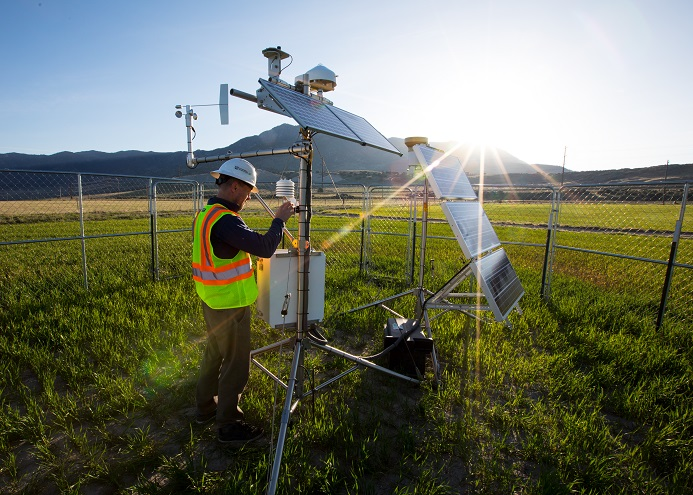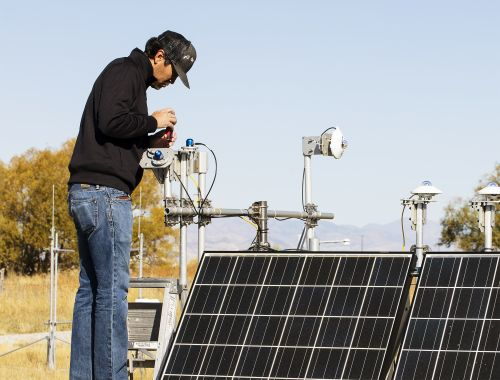Weather Solutions for IEC 61724-1 Class A Solar Monitoring Systems
de Libbie Anderson | Atualizada: 06/29/2020 | Comentários: 0
You may have heard of the IEC 61724-1 standard to promote international uniformity in PV (photovoltaic) system performance monitoring. But why was it created, and what does it mean for you? In this interview with PES (Power & Energy Solutions), Matt Perry, Technical Product Manager for the Renewable Energy Group, details what you should know about the IEC 61724-1 Class A standard.

Interview Q&A
Why are meteorological measurements so critical in understanding the performance of solar farms?
There are two fundamental questions that require quality meteorological data to answer: ‘how much solar radiation reaches the surface of the PV modules’ and ‘how much of this solar radiation is converted into electricity for a given module configuration’?
It may seem trivial to quantify with high accuracy and low uncertainty the amount of solar radiation that reaches the PV module surface given recent advancements in satellite and radiometric technologies; however, one must consider the seemingly random nature of solar radiation.
The uncertainty associated with monthly mean values derived from characterization of a given site’s climate is more than is commonly assumed. The amount of solar radiation – or more accurately stated, the amount of available solar radiation – is related to many complex phenomena such as the angle of incidence, diffuse/direct component distribution, albedo, spectral content, and random variations such as cloud cover, smoke from fires, or dust storms. The only way to accurately determine the amount of solar radiation reaching the PV module is through on-site measurement.
The behavior of solar modules is, of course, directly related to the amount of solar radiation that reaches the solar module, but it is also dependent on other meteorological parameters such as ambient temperature and wind. The power performance of PV modules is rated under standard test conditions, typically defined as 1000 W/m2, 25 Deg C cell temperature, and AM 1.5 spectrum. Short circuit current, open circuit voltage, cell temperature, and maximum power performance coefficients are all typically determined in controlled laboratory settings. However, modules rarely, if ever, operate under STC conditions. The only way to predict or verify performance of a PV system is to correct power-producing expectations to the weather.
Therefore, for analysts or grid/plant operators to produce high-confidence performance analytic or ground-truthing of satellite data, they rely on on-site measured data for input into their respective PV modelling exercise.
What is the IEC 61724-1 standard, and why was it created?
The IEC 61724-1 standard is the second revision of a guideline established to promote international uniformity in PV system performance monitoring. The completely revised and updated version introduces a monitoring system classification that specifies measurement parameters and sensor requirements, according to PV project size or monitoring objectives. The revised standard may be the first to present standardized methodologies for performing soiling measurements and calculating soiling loss indices.
How has the industry been impacted by the release of the IEC 61724-1 standard?
From my perspective as an engineer of weather station and performance monitoring systems, I am surprised how quickly the standard has been adopted. I think this adoption rate speaks to the industry’s need for uniform best-practice methodologies, for assessing PV system performance. The biggest impacts we are seeing are the adoption of soiling loss measurements as a standard weather station component, an increase in the number and quality of installed back of module temperature sensors and the addition of ventilation and heating on pyranometers.
Furthermore, we anticipate that maintenance of the weather station will be given more attention in order to maintain the Class A designation, which requires a schedule of high-quality checks.

Interestingly, implementation of this standard has not been limited to PV plants. Soiling, ventilation, and a more critical attention to maintenance are now common parameters on today’s solar resource assessment meteorological station. The standard has pushed us to innovate and expand the capabilities of the common met station with more built-in tools designed specifically at maintaining Class A quality.
Today’s standard solar resource assessment station, even from a year ago, is producing very high-quality, defensible data sets.
What are the most important considerations when deploying and commissioning these systems? What are things beyond the specification that should be considered?
Oftentimes, the weather and monitoring stations are afterthoughts: the last bit that needs to be checked off the list before the site can go on-line. But when Class A quality is critical, there are several parameters and considerations to keep in mind. The IEC 61724-1 standard simplifies this process by classifying the project’s goals and data accuracy requirements with measurement parameter and sensor requirements, but the considerations go beyond the standard’s scope.
At Campbell Scientific, we offer a training course that provides a detailed foundation of best practices for solar weather and monitoring stations. Details such as optimum site and instrument selection, which can be very complex, should be considered as well as issues such as dataloggers and communications. That being said, there are several considerations that are just as important, but often not given the attention merited – leaving the door open to potential data inadequacies.
Grounding, proper shielding and cable selection are critical aspects required to protect the instruments and keep the sensor signals clean. All of these considerations can be easily mitigated by working with an experienced instrument provider. That being said, the oversights we most commonly see in practice are lack of attention to cleaning and maintenance (particularly a lack of recalibration of sensors and dataloggers), record keeping, and consistent reviewing of the data to minimize bad data and quickly eliminate problems. Putting these practices into place then enables, with relative ease, systematic quality assurance and quality control of the data – a final step in identifying and correcting problems and ensuring quality data.

What are the biggest mistakes you see being made in monitoring?
In the previous answer, I mentioned several areas that if not properly mitigated will lead to lower-quality data sets, but perhaps one common mistake seen in monitoring would be lack of redundancy, particularly in plane of array irradiance on single-axis tracker sites and back of module temperature measurements.
Even with the exceptional reliability of modern single axis trackers, it is not uncommon to see something less than perfect alignment from row to row. Reliance on only one pyranometer mounted to a single tracker’s torque tube, for the plane of array irradiance measurement as representative of an entire site with many megawatts of PV, goes against the most basic quality assurance, quality control methodology and adds significant uncertainty to the assessment of expected power production.
In regard to back of module temperature, it is common to see temperature gradients greater than 5 deg C even across a single module, much less a string or entire array. A module’s output voltage, and therefore output power, is largely impacted by temperature. For example, the calculated power output between two identical modules with a temperature difference of 5 Deg C can be significant, 5-10 W. Therefore, it is important to utilize enough temperature sensors to get a reasonable average module temperature at any given time.
This is one benefit of IEC 61724-1. In attempts to help eliminate this mistake, it provides guidance on the relation between system size and the minimum number of pyranometers and back of module sensors necessary to achieve Class A accuracies.
What do you see being the future of monitoring in the solar industry?
I expect the trend toward higher-quality data to continue, supported with standards like IEC 61724-1 and the upcoming ISO 9060. I’m excited by all the new and refurbished measurement technologies that are coming in at much lower costs than just a few years ago.
To name a few, in the near future, I expect to see new soiling measurement and analysis techniques, more distributed generation or microgrid sites using an all-sky camera combined with system management, and more spectral measurements as PV module developers develop ways to utilize this data.
What do you enjoy the most about working in this industry?
I’ve been in PV since 2008, not as long as many of my colleagues but long enough to have a good idea where the industry is. Some say the golden era has passed, PV is now only big business, but I disagree. Maybe it is because I’m at a company whose roots are in research that I’m able to stay rooted in pure science and research, while also working closely with industry.
But, I still see people in both science and industry, dedicating their work to making a difference in the world, and this is what I enjoy most, this comradery I enjoy with my community, making better sensors and dataloggers, working toward higher-value data, streamlining cost and implementation.
Credits: This content originally appeared in PES (Power & Energy Solutions) Solar, Issue 33, 2018, and has been reprinted with permission. View the original article.
If you have any questions or comments about the IEC 61724-1 standard, post them below.
















 Libbie Anderson was the Marketing Assistant in the Renewable Energy Group and then the Environmental Group at Campbell Scientific, Inc. She worked to connect clients to Campbell Scientific solutions through marketing and media to educate people about Campbell Scientific.
Libbie Anderson was the Marketing Assistant in the Renewable Energy Group and then the Environmental Group at Campbell Scientific, Inc. She worked to connect clients to Campbell Scientific solutions through marketing and media to educate people about Campbell Scientific.
Comentários
Please log in or register to comment.